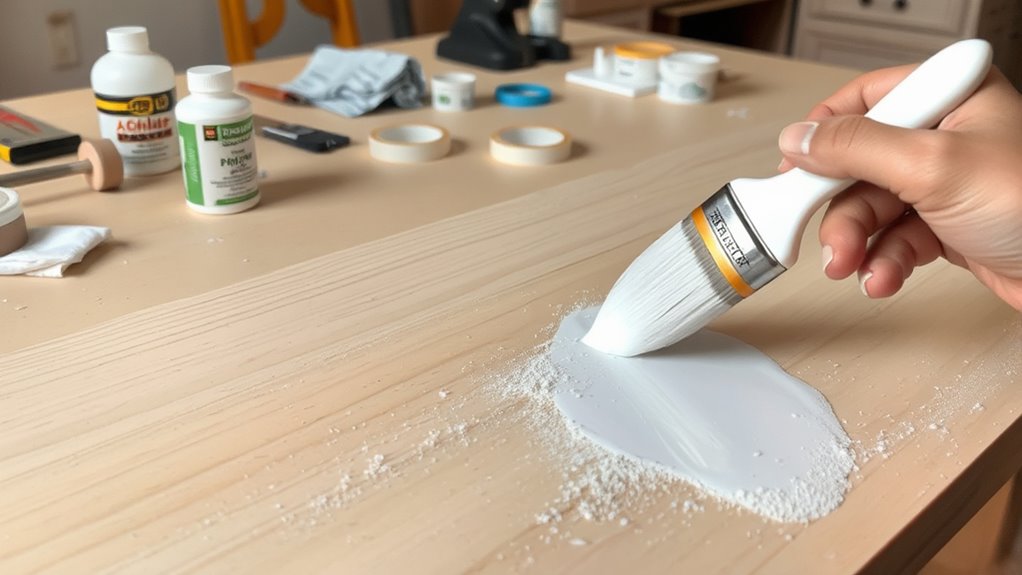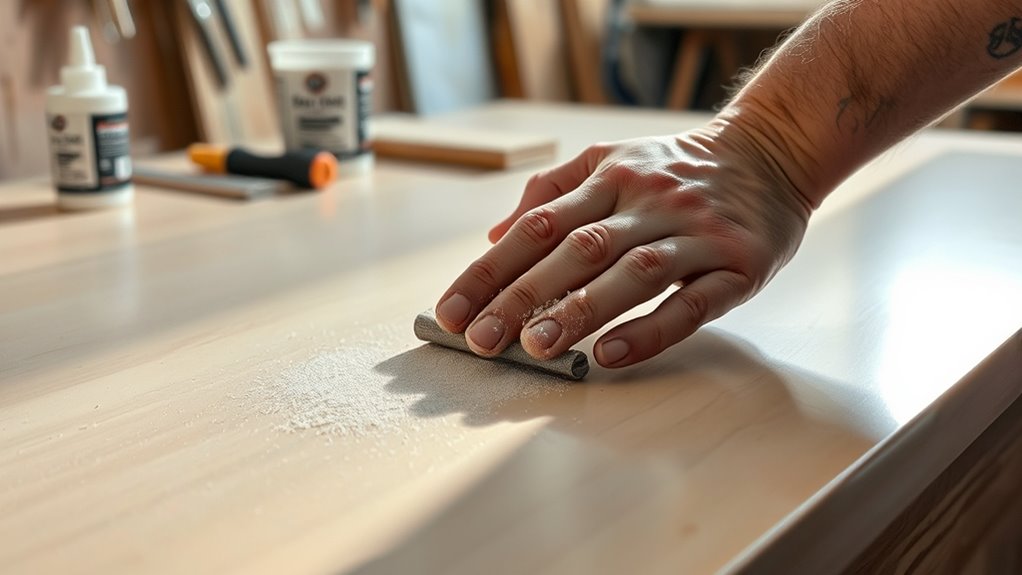To make certain your laminate furniture paint adheres well, start by cleaning the surface thoroughly with a mild detergent to remove grease and dust, then sand lightly with fine-grit sandpaper to roughen it up. Apply a high-quality bonding primer designed for laminate, and make sure it dries completely before painting. Use thin coats and proper tools like synthetic brushes or foam rollers for a smooth finish. If you want to discover more expert tips, keep exploring the essential surface prep tricks.
Key Takeaways
- Clean the surface thoroughly with a mild detergent to remove grease, dust, and grime for better paint adhesion.
- Lightly sand the laminate with fine-grit sandpaper to create a rough surface for primer and paint grip.
- Use a high-quality bonding primer designed for laminate surfaces to ensure strong adhesion and durability.
- Choose appropriate brushes or rollers, applying thin, even coats with long, smooth strokes for a professional finish.
- Allow proper drying time between coats, lightly sand between layers, and test paint on inconspicuous areas first.

Have you ever wondered if you can give your outdated laminate furniture a fresh new look without replacing it? The answer is yes, but success depends on proper preparation and application techniques. When it comes to painting laminate, adhesion can be tricky because of its slick, non-porous surface. That’s why understanding the right prep tricks and brush techniques is essential to achieve a durable, professional finish. One of the first steps is thoroughly cleaning the surface to remove grease, dust, and grime. Use a mild detergent or a degreaser, then rinse with clean water and let it dry completely. This ensures no residues interfere with paint adhesion.
Proper prep and brush techniques are key to successfully painting laminate furniture.
Next, lightly sanding the laminate with fine-grit sandpaper is vital. It creates a rougher surface, allowing the primer and paint to grip better. Pay special attention to edges and corners, where paint might be prone to chipping later. After sanding, wipe away dust with a tack cloth or a damp rag, making sure the surface is spotless before priming. Applying a high-quality, bonding primer designed for laminate surfaces is your best bet for adhesion. Follow the manufacturer’s instructions for drying times, and consider applying a second coat if needed for better coverage.
When it’s time to paint, brush techniques come into play. Use high-quality brushes suitable for the type of paint you’ve chosen—synthetic brushes work well with latex or acrylic paints, while natural bristles are better for oil-based finishes. Dip your brush lightly into the paint, removing excess to prevent drips. Use long, smooth strokes to apply the paint evenly, working with the grain and avoiding over-brushing, which can lead to streaks or uneven coverage. For larger flat surfaces, a foam roller can help achieve a smooth, consistent look. When it comes to color matching, take your time. Test colors on a small, inconspicuous area first to ensure they match your decor and your expectations. This step helps you avoid surprises once the entire piece is painted.
Having a steady hand and patience during application makes all the difference. Thin coats are better than thick ones, as they dry faster and reduce the chances of drips or uneven texture. After the first coat dries, lightly sand again with fine-grit paper to smooth out any imperfections, then apply a second coat for a flawless finish. Remember, proper prep, the right brush techniques, and careful color matching will help your laminate furniture look fresh, modern, and professionally done—without the need for costly replacements. Additionally, using proper surface preparation enhances paint adhesion and longevity, ensuring your project looks great for years to come.
Frequently Asked Questions
Can I Paint Laminate Furniture Outdoors?
You can paint laminate furniture outdoors, but you need to think about weather conditions first. Avoid painting in direct sunlight, rain, or high humidity, as these can affect adhesion and drying. Use a high-quality sealant, like exterior-grade polyurethane or outdoor-specific paint, to protect your work from the elements. Make sure to choose a calm day with stable weather for the best results and longer-lasting finish.
What Types of Paint Work Best on Laminate Surfaces?
You should use acrylic or latex paint for laminate surfaces, as they adhere well and are easy to work with. For best results, choose a high-quality primer designed for laminate to improve adhesion and prevent peeling. Always clean and lightly sand the surface before painting, and apply multiple thin coats for a smooth, durable finish. This combo guarantees your laminate furniture looks great and lasts longer.
How Long Should I Wait Between Coats?
You should wait about 2 to 4 hours between coats, depending on the paint type and room conditions. This allows sufficient drying time, giving each coat the chance to develop a durable, glossy finish. Keep in mind, the curing process continues even after the paint feels dry—so avoid heavy use for at least 24 hours. Proper pauses promote perfect, long-lasting results.
Is It Necessary to Sand Before Applying Primer?
Yes, sanding before applying primer is necessary because it improves adhesion and smooths the surface. Sanding benefits include removing gloss and creating a better grip for the primer, ensuring your paint sticks well. Even if the laminate feels smooth, light sanding helps the primer bond more effectively, resulting in a more durable finish. Skipping this step may cause peeling or chipping later, so take the time to sand lightly before priming.
How Durable Is Painted Laminate Furniture Over Time?
Your painted laminate furniture can be quite durable if you follow proper prep and painting techniques. With good adhesion, the paint’s durability guarantees your surface finish stays intact over time, resisting chipping and fading. Using high-quality primer and paint, along with proper surface prep, helps you achieve a long-lasting finish. Keep in mind that regular cleaning and avoiding harsh chemicals will also extend the life of your painted furniture.
Conclusion
Now that you know the key prep tricks and adhesion secrets, your laminate furniture is ready for a stunning transformation. But don’t stop here—there’s always more to learn about flawless finishes and long-lasting results. Will your next project be your best yet? Keep experimenting, stay curious, and watch your furniture become a masterpiece you’ll be proud of. The real magic happens when you push your skills further. Are you ready to take it to the next level?









